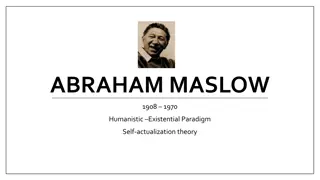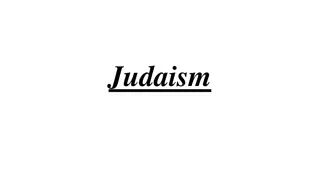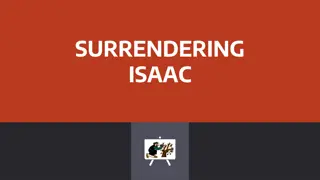Understanding Abraham's Importance in Judaism
Learn about the pivotal figure of Abraham in Judaism, his journey from rejecting polytheism to embracing monotheism, and the covenant made with God that led to the formation of the Jewish nation.
Download Presentation

Please find below an Image/Link to download the presentation.
The content on the website is provided AS IS for your information and personal use only. It may not be sold, licensed, or shared on other websites without obtaining consent from the author. Download presentation by click this link. If you encounter any issues during the download, it is possible that the publisher has removed the file from their server.
E N D
Presentation Transcript
KS3 Work booklet Judaism Name ________________________________________ Form ____________ Class ______________ INSTRUCTIONS ON THIRD (NUMBER 3) SLIDE
This page gives you tips on how to achieve the best results in your homework. Remember that it is your responsibility to go to the teacher BEFORE the homework is due to get extra help with any problems you may have. 1 Mark definition Questions This question requires you to give a brief explanation of what the term means, you can give an example if you are not sure. Make sure that you are specific when giving your answer e.g. Mosque = a mosque is a religious building where Muslims pray to Allah. 4 Mark Opinion Questions This question requires two opinions, each opinion should be justified using your understanding of the topic. You may want to give a religious reason for you opinion based on religious practice or teachings or you can give an example. Answers should be structured using PEE. 4 Mark Importance Questions This question requires you to give two reasons for why a topic is important. You need to explain each point that you give by using examples and link the importance to religious teachings. Answers should be structured using PEE. 6 Mark Discussion Questions This question requires you to give at least two different viewpoints and reasons for why you or someone might have that view. You need to explain each point that you give by using examples and link the importance to religious teachings. Answers should be structured using PEE. Top Tips Use key terms whenever you can Make sure that your spellings are correct Use full stops and capital letters. Useful websites: www.truetube.com www.bitesize.co.uk
This link takes you directly to Judaism on the BBC Bitesize website. https://www.bbc.co.uk/bitesize/topics/z4hg9j6 Use this to help you answer questions. You can write on the PowerPoint. You will need to download it and then submit it to google classroom with the questions completed. (Yellow slides are the questions you need to answer) Try your best! Mr Jones
Abraham Abram was born in Ur, but spent much of his childhood in Haran. In Haran they believed in hundreds and thousands of Gods. This belief was called Polytheism. Abram disagreed with their beliefs and so decided just to believe in one God. This is known as Monotheism. Abram felt strongly that God was guiding him in his thoughts. Leave your country and father s family... take your wife and go to another land I will tell you when you have arrived He felt that God was telling him to travel to Canaan. Abram travelled to Canaan with his wife Sarai. God promised him that they would have a special relationship, Abram would have many descendants [followers] and he would become the founder of a new religion and nation: The Jewish Nation. The number of stars found in the sky told Abraham how many followers he would have. For this to work, God asked Abram and Sarai to do two things: Change your names to Sarah and Abraham Circumcise all the boys in your family If you do these things, it will show that you belong to me. This agreement was called Covenant.
1. Who is Abraham? (1 mark) 2. Explain one important event that happened in Abraham s life ? (4 marks) 3. Why do you think this is the most important event? (4 marks)
1. What is a covenant? (1 mark) ________________________________________________________________________________________________________________________________________________________________________ 2. What is a descendent? (1 mark) ________________________________________________________________________________________________________________________________________________________________________ 3. What was Abraham told to do by God? (4 marks) ______________________________________________________________________________________________________________________________________________________________________________ 4. Why is this so important in Judaism? (4 marks)
The Story of Moses Pharaoh, the King of Egypt, had made a law that every boy baby of the Hebrew race should be killed, and there was great sorrow because of it. But when Moses was born, his mother managed to hide him for three months; then she made a cradle, or little ark, and putting him into it, carried him down to a river and hid the cradle among the reeds there. Soon after this, Pharaoh's daughter came with her maidens to the river-side, and when she saw the beautiful child, she sent one of her maidens to bring it to her. She took the little boy to the palace and named him Moses, and he became a great man among the Egyptians; he knew, however, that he belonged to the Hebrew race, and when he saw how badly his own people were treated, he tried to help them; but at last he was obliged to leave Egypt, and became a shepherd, taking care of the flocks of a priest called Jethro. He also married Jethro's daughter. After a time, God spoke to Moses out of a burning bush, and told him that he must go and rescue his people from the cruel Egyptians. Moses thought he could not do this; but God promised to help him, and to show him what he would be able to do with that help, God turned the rod which Moses carried into a serpent. Then God told Moses to pick the serpent up by the tail, and as he did so, it became a rod again. He showed him another sign, also; but Moses was still afraid, because he could not talk well and thought that Pharaoh would not listen to him. So God told him to take his brother Aaron for a spokesman. Moses and Aaron, therefore, went into Egypt, where they called together the chief men among their own people, the Hebrews, or Israelites, and told them what God had commanded. Moses also did the miracles which God had given him power to do, and the people believed that God had sent him. After this Moses and Aaron went to Pharaoh, and told him that it was the Lord's command that he should let the Israelites go. Pharaoh knew nothing about God, and became very angry, saying that Moses and Aaron kept the people from their work by telling them such things; and he treated the poor Israelites worse than before. But Moses had faith in God; so he was able to perform before the king the wonderful things that he had done before his own people; still, Pharaoh would not let the children of Israel go.
Then Moses turned the waters of the rivers into blood; and after that he caused large numbers of frogs to run over the land and through the houses, doing great harm. He also brought locusts and other insects to be a pest to the people, and caused many of the useful animals which belonged to the Egyptians to grow sick and die, doing all these wonders with the rod which God had given him. But Pharaoh would not listen to him. Then God commanded Moses again, and he brought other plagues upon the Egyptians; but Pharaoh would not give up. At last, however, God sent a still more terrible trouble; for the first-born of every Egyptian family, and even the first-born among their flocks, died; although the Israelites, who were constantly praying to the Lord and making sacrifices, were spared, as they had been all the time. Then Pharaoh was frightened into obeying God, and he let the Israelites go; so they started at once for the land of Canaan, and the Lord guided them by a cloud, which at night looked like a pillar of fire. When the Israelites had reached the Red Sea, they found that Pharaoh was pursuing them with a large army. But God commanded Moses to stretch forth his rod over the sea; he did so, and the waters parted, making a high wall upon either side, so that the children of Israel passed through and reached the other side in safety. Pharaoh and his hosts followed and were all drowned. When the children of Israel saw that they were safe, they sang a beautiful song of praise to God, and then they went on their way again. After they had travelled for some time, they were in need of bread and meat, and they complained about Moses because he had brought them to a land where they had not enough to eat. But God sent them plenty of quails and also a substance which they could use for bread. Later, when they wanted water, the Lord commanded Moses, and he struck a rock with his rod, and pure water poured out of it, so that the thirsty people and their animals had all that they wanted. In this way God took care of them as they journeyed through the new and strange country toward the promised land, and Moses became the law-giver of the Israelites, receiving his commandments from God.
1. What is the exodus? (1 mark) ________________________________________________________________________________________________________________________________________________________________________ 2. What is an Israelite ? (1 mark) ________________________________________________________________________________________________________________________________________________________________________ 3. What was Moses told to do by God? (4 marks) 4. Why is this event so important in Judaism? (4 marks)
1. Who is Moses (1 mark) 2. Explain one important event that happened in the life of Moses ? (4 marks) 3. Why do you think this is the most important event? (4 marks)
Extension: Passover 1. At Passover, Jewish families hold a service called a Seder, which includes a special meal. Each part of this meal is symbolic. This means that it represents, or reminds people of a certain part of the Passover story. The Seder Plate is a meal of remembrance that is shared and celebrates Jewish freedom from Egypt. Find out what the following represent. Three other things are present on the table for the Seder. 1. A dish of Matzot which a re flat cakes of unleavened bread that remind Jews that they could not wait for bread to rise in their escape. 2. A bowl of salt water to remind them of their tears cried in their unhappiness as slaves of Egypt. 3. A wine glass for each person. It is drunk 4 times in the meal for the 4 times God promised to free the Jews.
1.The lamb bone 2.2. A hard boiled egg 3. Green vegetables (lettuce or parsley) . Bitter herbs (horseradish) 5. Charoset (mixture of nuts, apples and wine
The Ten Commandments 1. You shall have no other Gods before me. 2. You shall not worship idols. 3. You shall not misuse the name of the Lord. 4. Keep the Sabbath holy. 5. Honour your father and mother. 6. You shall not murder. 7. You shall not commit adultery. 8. You shall not steal. 9. You shall not lie. 10.You shall not covet (be jealous).
The Torah is the first part of the Jewish bible. It is the central and most important document of Judaism and has been used by Jews through the ages. Jews believe that God dictated the Torah to Moses on Mount Sinai 50 days after their exodus from Egyptian slavery. They believe that the Torah shows how God wants Jews to live. It contains 613 commandments and Jews refer to the ten best known of these as the ten 10 statements. The Torah is written in Hebrew, the oldest of Jewish languages. It is also known as Torat Moshe, the Law of Moses. The Torah is the first section or first five books of the Jewish bible. However, Tanach is more commonly used to describe the whole of Jewish scriptures. This is an acronym made up from the first letter of the words Torah, Nevi im (prophets), and Ketuvim (writings). Similarly, the term Torah is sometimes used in a more general sense to incorporate Judaism s written and oral law. This definition encompasses Jewish scripture in its entirety including all authoritative Jewish religious teachings throughout history. The word Torah has various meanings in English. These include: teaching, instruction and law. For Jews the Torah means all of these.
The scrolls are not directly touched when unfurled on the Bimah (raised platform in middle of the synagogue). A pointer or Yad (hand) is used instead. This is in the shape of a hand with an outstretched finger. The reading or chanting is performed by a person who has been trained in this task. However it may be carried out by the rabbi. It is a very great honour for a congregant to be asked to attend at a reading during a synagogue service. This is called having an Aliyah which is Hebrew for going up. The weekly portion or Sedrah is followed by the recitation of part of another of the Jewish holy writings.
1. What are the Ten commandments ? (1 mark) 2.Why are the Ten commandments followed? (4 marks) 3. Why do you think the Ten commandments were given to Moses? (4 marks)
Extension The laws of the 10 commandments are only found in Christianity. Discuss own and opinion and give reasons for your answer. Provide another viewpoint.
1. Name the holy book in Judaism. (1 mark) _ 2. List two things the Torah contains. (2 marks) 3. Explain why someone might read the Torah. (4 marks) 4. Explain why the Torah might be important for Jews. (4 marks)
5. The Torah does not matter in the 21stCentury Discuss this statement (6 marks) Give your own opinion; do you agree or disagree? You also need to provide a different point of view (someone who might disagree)
Extension task Compare the similarities and differences between the Torah and Quran. Similarity Difference Same
Synagogue The synagogue is the Jewish place of worship, but is also used as a place to study, and often as a community centre as well. Orthodox Jews often use the Yiddish word shul (pronounced shool) to refer to their synagogue. In the USA, synagogues are often called temples. Clothing during worship Hats and prayer shawls Everyone except unmarried women wears a hat in synagogue in order to show reverence to God. (And once unmarried women pass a certain age they usually wear a hat too.) Jewish men always wear hats when they are saying prayers which mention God's name. Observant Jewish men wear a hat almost all the time. The most common hat for men in the synagogue is a small round cap called a yarmulke (Yiddish) or a kippah (Hebrew), but an ordinary homburg or street hat will be accepted. Hats are always available for visitors, but a hair grip comes in handy to keep a kippah on. Adult men (i.e. those over the age of 13) often wear a Tallit or prayer shawl for morning prayer. A Tallit has fringes (called tzitzit) on the edges to remind the wearer to observe God's commandments - as commanded by God in the Bible.
Segregation In Orthodox synagogues men and women sit separately, and everyone (except young girls) has their head covered. In a Reform synagogue men and women can sit together. The service Synagogue services can be led by a rabbi, a cantor or a member of the congregation. Traditional Jewish worship requires a minyan (a quorum of ten adult males) to take place. In an Orthodox synagogue the service will be conducted in ancient Hebrew, and the singing will be unaccompanied. Few British synagogues now have a choir, but they are more common in the USA. In a progressive (Reform, Liberal) synagogue the service will be at least partly in English, there may a choir and instruments, and men and women can sit together. The Ark and the Torah Every synagogue contains an Ark, which is a cupboard where the Torah Scrolls, which contain the text of the Hebrew Bible, are kept, and a desk from which to read the Torah. The Hebrew words of the Ten Commandments are usually written somewhere above the ark. The Ark is named after the wooden chest which held the stone tablets of the Covenant that God gave to Moses on Mount Sinai. The search for that original Ark formed the plot of the movie Raiders Of The Lost Ark.
1. What is the name of the place of worship in Judaism? (1 mark) 2. List two main features of a typical Synagogue . (2 marks)
3. What do these two features represent? (2 marks) Challenge: Why are they important?
4. Explain why the Synagogue might be important place for Jews. (4 marks)
Debate- Should all Jews wear religious articles of clothing to show their faith in God? Think of different view points and give own opinion. Some might say yes because Some people may say no because I believe .























